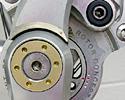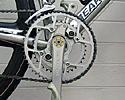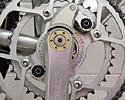
Recently on Cyclingnews.com |
Reviews
Rotor Cranks: Power to the people
By Ben Larsen
 |
 |
The ROTOR Concept Kit (RCK or, for the sake of convenience, Rotor crank) is an integrated set of cranks and bottom bracket that is designed to improve pedalling efficiency. The makers claim that by varying the angle between the cranks, RCK optimises power output by significantly reducing the dead spots at the top and bottom of your pedal stroke while still using circular chain-rings.
What the?
Legs evolved to walk, run and to push down when we're, say, walking uphill. Pedalling involves the feet going round in circles, and to many people that means there are inefficiencies getting power from the up and down movement of our legs to match the movement of our cranks. The big problem has been that at the top and bottom of the pedal stroke, it is extraordinarily difficult to transfer much power to the axle as a turning force.
The RCK is not the first attempt to overcoming this limitation. Previous solutions have ranged from systems like PowerCranks, which force the rider to apply force more continually throughout the pedal cycle, to oval or ecliptical chain rings such as Shimano's Biopace rings back in the mid/late 1980s.
Each of these solutions however, has had its detractors or practical limitations. PowerCranks may be a great training tool but are not practical to race on, and the oval chain-ring variations never shifted really well, felt strange to many people eventually vanished in the early 1990s amid never-proven allegations of contributing to knee problems.
Development of the Rotor Cranks
The Rotor idea first came from Aeronautic Engineering School students in Madrid in 1995. Seeing that the idea had merit, the designers then set up a business to finish the development and start manufacturing them.
Early versions became available in 1998 along with claims that the RCK system increases power by 16 percent, reduces lactate production by 15 percent, and reduces heart rate by 5 percent.
Since then, the RCK design has been refined from a complex system that needed a special frame to the current model that can be fitted to any bike without any changes. The RCK system has also been approved by UCI officials for competitive use and has seen some pro's using it (most notably members of the Relax Fuenlabrada team), especially in Spain where the company is based.
How the Rotor Cranks work
 |
The theory behind RCK is simple but the practical application is a little hard to get your head around.
The RCK System is a crankset in which the cranks are not fixed at 180º, but are variable during a pedal cycle. The cranks are synchronised through a set of cams that change the angle between the crank arms producing a variation in transmission ratio during each cycle.
The system relies on an eccentric bearing on the bottom bracket (BB), and the right crank movement is then controlled by the two cams accelerating the crank through the 'dead spot' at the top and bottom of the pedal stroke and prolonging the power stroke phase.
What all this means in real terms is that by the time one crank is at the bottom of the stroke and in the six o'clock position, the opposite crank has been accelerated through to the one o'clock position and has already started the power stroke phase.
Set-up
Set-up is a relatively simple process and the instructions that are included are pretty good. Firstly you need to remove your current cranks and bottom bracket. The RCK right crank arm and bottom bracket are integrated and are simply wound into your bottom bracket shell as you would a normal cartridge bottom bracket. You then fix the bottom bracket in place using a lock ring as you normally would with some micro adjustment to set the cranks (the cranks can be set to change the amount of leverage in the power phase) and tighten into place using the supplied lock ring tool. Attach the left crank arm and tighten as you normally would and - voila! you are ready to start "rotoring". Total time required is 30-45 minutes.
On the road
Initially, pedalling on a Rotor equipped bike feels quite weird. The back of your pedal stroke especially feels a little bit like riding slowly on a fixed wheel bike where the pedals are forced over the top of each stroke by the back wheel rather than by the force you are applying yourself. Putting a few different riders on the bike to get a range of first impressions, it seems that more proficient cyclists who normally 'pick up' their feet during the upstroke found it far stranger than cyclist with poor technique who are perhaps lazier in this area of their stroke anyway.
 |
Areas of continued weirdness include back-pedalling, and high speed cornering. The eccentric movement is more noticeable when back-pedalling and the cornering position of your inside pedal is moved forward which takes a little getting used to. The fact that both of these actions tend to happen when careering down hills is perhaps why the effect is initially so obvious.
As peculiar as the Rotor cranks initially felt, the adaptation was almost complete inside three rides on consecutive days and I started getting a feel for what the cranks were actually doing. The big difference riding these cranks is that you don't get stuck on the top of too-big gears. This leads to the inevitable tendency to ride huge gears just because you can still turn them over - this is particularly true on climbs and at high speeds on the flat. In contrast to the increased big gear turning ability, there is an obvious lack of smoothness in your new stroke making it difficult to maintain high cadences (115rpm+) comfortably.
After a week of regular riding I was completely adapted and getting back on 'normal' cranks felt weird. Changing back is perhaps the best illustration of what the cranks are doing for you - you become acutely aware of just how dead the 'dead spots' are and how choppy your pedalling motion is. The RCK actually allows you to be a lazier rider and simply lets you use your leg muscles to do what they do best: push.
Testing
During the months I have had the cranks on my bike I have repeated a 10km time-trial course several times and raced a few criteriums, a road race, and the Hawaii Ironman. During this period my focus was on Hawaii so the vast majority of my training was long and slow, the kind of training that builds fitness and endurance but not a lot of out and out speed.
The 10km time-trial course is close to my home and is rolling hills; I ride it often and have three years of periodic testing over the same course with heart rate files so it works pretty well as a real-life laboratory. Over three years of testing my times tend to range from 13m40s to 13m50s with average heart rates of 163-165 (Hrmax = 182) when I am in good form. The only repeatable variations from that pattern came when I was part of the EPO test validation program in 2000. During this period I managed to ride the course consistently at 13m00s-13m10s with slightly lower heart rate averages but I have never managed to consistently get that low again - until now.
With the Rotor cranks on the bike I have managed to consistently complete the course in 13m05s-13m15s over a three month period with average heart rates of 161-163 being a few beats lower than without. I have ridden the course on several occasions during that same period on standard cranks and been unable to ride within 20 seconds of my RCK times, even at slightly higher average heart rates.
My other race experiences were positive. The road race was a 40km handicap that I managed to attack early and ride 37km solo to win, and the crits were fine albeit cornering was a little crazy due to the 3-4mm drop in effective BB height making pedalling through corners a little more daring. The lack of smoothness may also curtail top end sprint ability, but I am a crappy sprinter so this is not objective in any way.
At Ironman in Hawaii I rode a personal best time of 4hr56m for the 180km course and made an 11m30s improvement on my Ironman New Zealand bike split in March. By contrast, the average variance of the 77 qualifiers from NZ who subsequently raced Hawaii was a 4m30s deterioration over their NZ splits.
Conclusion
The positives: The Rotor crank is different from alternative solutions like Biopace because it almost completely eliminates the 'dead spot' when the crank is in the vertical position. Excluding sprints, the RCK system seems to improve performance in all aspects of road cycle racing for all riders, whereas other systems tend to offer most improvement to poorer riders. The quality and machining is really high.
The negatives: The set up is slightly heavier than its standard counterpart weighing 240gm (25 percent) more than Dura-Ace, but this is not something that I could notice while riding. Cornering is slightly compromised due to a slightly lower effective bottom bracket - at least it is on my frame. Sprinting and maintaining high cadences (115rpm+) for prolonged periods is not as fluid as with standard cranks. Long-term reliability is unproven, although I have done 6,000km without issues. They are not cheap, costing about 25 percent more than Dura-Ace.
The bottom line: The RCK works, it is simply a matter of how much. My personal testing almost reflects Rotor's claims of improvement but I would probably say they are worth around 1.5 - 2 minutes an hour rather than 3. The fact is that is still a lot of time that I cannot find elsewhere and especially for tri's and time trials this is easily the difference between 1st and 10th. The weight is negligible and even on a really hilly race the advantage would easily eclipse the weight penalty. The only road racing situation in which they are perhaps less suited is in criteriums but even then it may be a trade-off, otherwise there is a clear advantage.
Existing sponsorship deals will prevent these from being on many pros bikes anytime soon and road cyclists' general aversion to anything radically new (remember tri-bars?) will mean that these will be a product that must prove themselves repeatedly before they are picked up on a broad scale.
The question begs, "If Lance Armstrong was winning the Tour de France on them and Shimano's marketing team was on the case, would we not already all be riding them?"
Photos
Weight: 1200g (complete cranks/bottom bracket/chain-rings 39-53)
Recommended retail price: £390 with titanium axles (£295
with steel)
Pro: You go faster for the same effort
Con: Weight, cost
More information: Rotor's
website
Cyclingnews Rating: ![]()
What do you think of the Rotor Cranks? - Tell us your thoughts
Recent techTour tech: Zipp's slippery
new wheel revealed |

